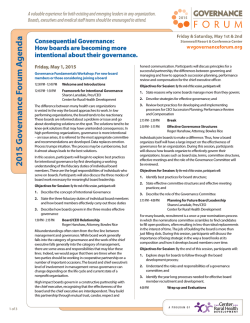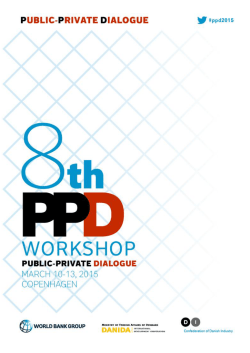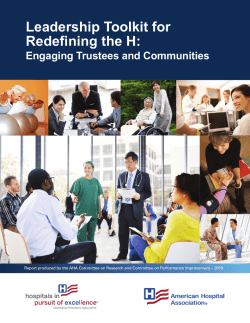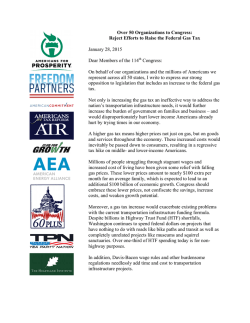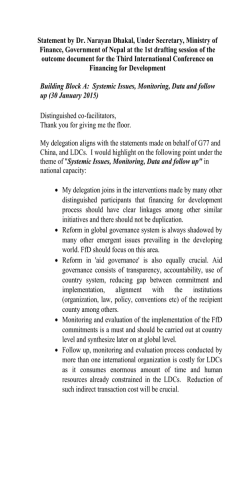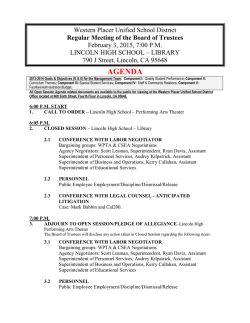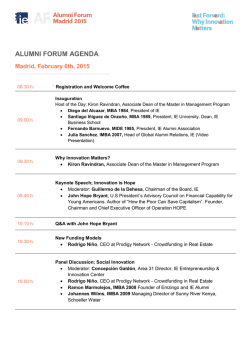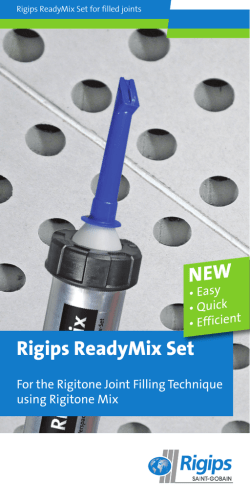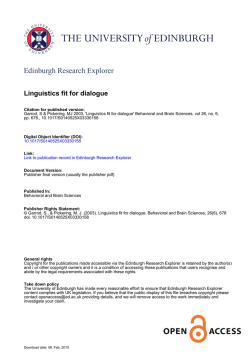
Engaging Trustees in the Redefinition of the H
Engaging Trustees in the Redefinition of the H Tools and Resources Tools and Resources Tool 4 – Current High-Performance Governance Practices Tool 5 – Competency-Based Board Composition Tool 6 – Creating the Right Boardroom Conversations Tool 7 – Seven Steps to Designing an Effective Governance Education Process 2 Tool 4 Current High-Performance Governance Practices 3 For boards to participate in shaping their new organization, they must be currently performing at an extremely high level. The following is a list of four practices that hospital and health system boards must be engaged in today, in order to be successful in the future. 1. Define a Clear Mission and Vision for a Transformed Enterprise Hospital and health system boards should consider the organization’s vision for improvement of the community’s health, as well as approaches to address population health and manage risk in light of today’s transforming health care delivery and payment systems. This is not the hospital’s responsibility in isolation, but rather an opportunity for hospitals to build relationships and partnerships in the community to impact the overall health of the community. Hospital CEOs and boards must agree upon and clearly articulate the extent of the responsibility and engagement of the organization in community and population health. While the commitment and responsibility will vary among organizations and communities, it is essential that hospitals do not let changes in payment models drive the mission and vision of their health care system. Payment reform is occurring in varying degrees across the United States. In the longterm the transition may help hospitals and health systems to more effectively support health in addition to health care. However, as hospitals progress through the transition, it is imperative that the board and CEO work together to agree upon the degree to which they can achieve the Triple Aim given evolving payment constraints. The absence of payment reform and financial incentives should not prevent hospitals and health systems from doing the right thing for patients and communities or from contemplating their mission and vision with respect to their community needs, cost sustainability and articulation of a strategy that embraces all facets of the Triple Aim. The board’s responsibility for serving the mission and vision must remain steadfast during this transitional period. 2. Create an Environment of Trust Mutual respect and absolute trust between the board and its CEO is absolutely vital to organizational success. The data suggest that in an era of transformation trust may be strained. To build mutual trust, the board and the CEO must rely on one another for support, consultation and advice, and complement one another’s strengths and responsibilities. The hospital or health system CEO must build a positive rapport and close professional relationship with all board members. He or she must understand clearly what motivates each trustee to be involved with the organization, and be deeply knowledgeable about the interests and needs of each individual trustee. The CEO must also be aware of any gaps in trustees’ understanding of current issues and trends, ensure that regular board education responds to trustees’ needs, and encourage trustees to learn and ask questions in an open, safe environment. CEO attentiveness to individual trustee needs demonstrates interest and support, and helps build a positive, trustful environment for dialogue and decision making to take place. Most importantly, CEOs must understand that trust begins with transparency. Holding back or “sanitizing” information will likely result in a board that is doubtful, lacks trust and perceives a sense of responsibility to inappropriately “dig in” to operational details, managing at the micro level versus leading at the macro level. Conversely, when boards 4 are confident that all relevant strategic information is shared with them, they partner with the CEO on a foundation of trust on leadership issues focused on strategic and generative thinking about the organization’s future. Five Essentials for Building Board-CEO Trust 1.Clear, honest, consistent and transparent communication 2.Close personal ties among the CEO and board members 3.Consistent adherence to mutually agreed upon roles and accountabilities 4.Mutual commitment to the hospital’s or health system’s mission and vision 5.Continuous governance knowledge-building enthusiastically supported by the CEO, both practically and financially 3. Establish a Foundation of Effective Communication The board meeting is the center of communication and relationship success or failure. Unfortunately, board meetings are often not as effective as they should be due to poorly planned agendas, time wasted on routine reports and too much emphasis on operational issues and details. Board meetings too often include agenda items that have little relevance to and impact on the long-term strategic direction of the organization, when instead they should focus on the mission, vision and strategic leadership issues critical to future success. Effective, high-performance boards spend most of their time on important strategic and policy issues. They engage in rich discussion and dialogue, assess outcomes, and participate in ongoing education. These boards focus on the issues that are most critical to the organization, and where they can have the greatest impact. The CEO plays a major role in this area. He or she should ensure that trustees receive relevant, concise, action-focused information to review well in advance of board meetings to ensure board members have sufficient time to understand issues and their implications. In addition, the CEO should work closely with the board chair to ensure that meetings are orchestrated to maximize meaningful dialogue and maintain a consistent focus on the future. Board dialogue and discussion are most meaningful when board committees are properly used. Committees often do the “heavy lifting,” framing the issues of importance for the full board and preparing trustees in advance with a clear set of questions to provoke strategic dialogue. 5 Five Keys to Building Effective Board-CEO Communication 1.Clarity of expectations 2.Openness and candor 3.CEO understanding of the unique communication preferences and styles of individual board members 4.Open channels of information and dialogue between board meetings 5.Compelling, strategic, dialogue-rich board and committee meetings 4. Build a Board-CEO Co-Leadership Partnership Board members sometimes, knowingly or unknowingly, begin to wander into the CEO’s domain, and the results of that meandering can be problematic. To avoid “purpose wandering,” roles and responsibilities should be clearly expressed in writing. This helps define the fine line between strategic leadership and operational leadership. Too often roles and responsibilities are unclear and unfocused. A formal, written set of roles and responsibilities will help prevent both the board and the CEO from inappropriately trying to assume the other’s responsibilities. Hospital trustees should have their “noses in, but their hands out.” This means that boards should energetically exercise “reasonable inquiry,” delve deeply into the rationale behind strategic thinking and proposals, and always relate the organization’s strategic focus to its mission and vision. They should not inappropriately delve into risky management-level discussions and decisions. For example, while the board is responsible for the high-level strategic focus and direction of the organization, the CEO and his or her administrative team are responsible for the day-to-day operations and details of designing action plans for implementing the strategic plan. One is the “what,” and the other is the “how.” Key Components of a Strong Board-CEO Relationship Establishing a productive, trustful and successful relationship takes commitment on the part of the board and the CEO. A number of ingredients are inherent in a good board-CEO relationship, including: 1.Communication is clear, crisp, concise and accurate. 2.Both the board and the CEO are “on the same page” and have a mutual understanding of issues. 3.Roles, responsibilities and accountabilities are clear and well expressed. 4.The board has a clear understanding of its policy and strategic “place” in the leadership continuum. 5.A strong sense of synergy results from a mutual understanding of what the CEO and the board bring in tackling the complex challenges that face the organization. 6 Tool 5 Competency-Based Board Composition 7 In 2007, the AHA Center for Health Care Governance’s Blue Ribbon Panel on Competencybased Governance identified the following essential board characteristics, skills and experience: n Characteristics: Reputable, intelligent, big-picture thinker, objective, open to new ideas, highly engaged, proactive, able to ask tough questions and able to challenge others in a nondisruptive way, embraces organization’s values. n Experience: Demonstrated leadership, board experience, community involvement, particular business achievements. Some board members should have clinical experience. n Skills: Specific expertise in one or more of the following: finance, quality, business partnerships, legal. In addition, strong relationship skills. n Core values: Respect, integrity, compassion, excellence. In 2009, a follow-up Blue Ribbon Panel report identified two sets of core competencies for board members of hospitals and health systems. First, the panel identified the knowledge and skills that all boards, regardless of the type of hospital or system they govern, should include: 1) health care delivery and performance; 2) business and finance; and 3) human resources. Knowledge and Skills: Health Care Delivery and Performance. Board members should have the knowledge and skills to: n Track measures of quality, safety, customer satisfaction, financial and employee performance. n Ensure patient and customer satisfaction survey results, as well as demographic and epidemiological statistics, are used to set organizational priorities, plans and investments. n Monitor and evaluate organizational success by tracking community wellness and clinical performance against benchmarks. n Anticipate community needs. n Ensure close adherence of performance to the Institute of Medicine’s six aims: to provide care that is safe, timely, effective, equitable, efficient and patient-centered. n Advocate for care decisions that are evidenced based. Knowledge and Skills: Business and Finance. Board members should have the knowledge and skills to: n Guide development of long-term plans for funding growth and development. n Oversee development of revenue sources and understand their financial implications. n Consider the impact of reimbursement and payment systems when assessing management alternatives. n Oversee development of long-term capital spending for renovation and expansion of facilities, equipment and services. Human Resources (employees, physicians, volunteers, etc.). Board members should have the knowledge and skills to: n Ensure human resource functions are aligned to achieve organizational strategic outcomes. n Ensure that recruitment and selection, job design and work systems, learning and development, reward and recognition and succession planning are aligned to encourage behaviors and performance needed today and into the future. 8 The panel further recommended several personal capabilities that should be sought in all board members: nAccountability n Innovative n Achievement n Organizational n Change orientation leadership thinking awareness nProfessionalism nCollaboration n Relationship n Community orientation n Strategic n Complexity management n Talent n Information seeking n Team building orientation development leadership While critical competencies (skills and knowledge) are important, what differentiates excellent board members are characteristics that cannot be taught in an educational seminar: self-image and values, social role, traits and personality, and motivation. (See Beyond the Visible Director Competencies: Select for Core Values graphic below.) How a trustee perceives the role of the hospital in the community and his or her role on the board impacts leadership style and decision making. A trustee’s self-image must be appropriately aligned with the new enterprise, and trustees must possess the personality and intrinsic motivation necessary to serve. The best trustees are motivated by achievement of the hospital’s mission. Beyond the Visible Director Competencies: Select for Core Values Source: Nygren Consulting, LLC 9 Tool 6 Creating the Right Boardroom Conversations 10 Prioritize Agendas Establishing well-organized and consistent governance processes and procedures enables the board to be most productive, and ensures that its time is allocated to the most critical topics. Agendas should reflect the most important strategic issues and priorities, and make efficient use of trustees’ valuable and limited time; meetings should be designed to maximize trustees’ ability to engage in critical dialogue; and committees and task forces should be used to enable the board to focus time on high-level strategic discussion. Agendas should not be so full and rigid that there is too little time for deep discussion and generative dialogue on the strategic issues that matter most to the organization’s future. One way to ensure that agenda items are necessary is to organize the agenda by strategic pillar or goal. If an agenda item does not fit well under a strategic pillar, it may not be appropriate for discussion at the board meeting. Minimize Presentation, Maximize Discussion Most board meetings include staff-led presentations on various topics and issues. In many cases, these presentations too often review information that trustees should be expected to digest and understand as part of their board meeting preparation. Informational reports should be synthesized into brief executive summaries that outline why the information is important and relevant to board knowledge and potential action. When appropriate, the summaries may include key considerations, options for discussion, and recommended direction from the CEO. In all cases, unless the information has some action attached to it, it should not consume valuable meeting time that can instead be spent on generative discussion and a focus on strategic thinking and planning. Focus on Strategy Boards of trustees must focus their time and energies on the most pressing strategic, future-focused issues and plan proactively and flexibly for rapid change and uncertainty. They must develop the expertise to recognize and solve longer-term issues, and ensure a synergy and consistency of activities and strategic direction. The structure and makeup of the board must mirror the organization’s strategic priorities. Engage in Scenario Thinking In today’s highly complex and rapidly changing health care world, there are no straight lines to the future. Boards must take the time to consider the many different possibilities of market change, driven by internal and external factors. One way to assess the impact of possible events is to predict various futures that may develop, and think through scenarios that reveal where the organization might be and what actions it might take should the scenario, or some version of it, occur. This can push the board to continually think into the future, and prepare thinking to anticipate future developments. Boards should then develop “dependent strategies,” or planned responses to different circumstances that may occur. Focus on the Emergent Boards can easily become overly focused on the here and now, and not devote enough strategic thinking to the future. Boards must continually adjust their focus to deal with the issues ahead, not the issues of the past. Creating time on the agenda for meaningful discussion of the most significant issues facing the hospital ensures that future issues, challenges, barriers and opportunities are considered. Time should be primarily focused on 11 understanding trends and strategic priorities, rather than dealing with operational details; the focus should be on future-oriented strategic thinking about challenges and issues. Listen Artfully Miscommunication and misjudgment often are a result of inadequate listening. To ensure strong, effective governance communication, boards should acquire and absorb new ideas, listen attentively without rushing to judgment, and absorb information before offering a definitive response. Stimulate Critical Conversations Board and committee meeting time is limited, and every minute should count. Board members must ensure their governance conversations are always vibrant, vital, and focused on purpose and outcomes. Dialogue should be the board’s “social operating mechanism.” It is through holding critical conversations that decisions are made, grappling and grasping with concepts, ideas and practical solutions that lead to more informed and rational conclusions. Issues can be framed in advance by including generative-based strategic questions for discussion in pre-meeting materials. Value Constructive Confrontation Without constructive challenges to conventional wisdom and thought, the best solutions may never surface. Boards should regularly confront issues by challenging assumptions and exploring alternatives to traditional thinking. Doing so may cause short-term tension and disagreements, but this tension should be welcomed and resolved through thorough, organized, deliberative dialogue. Listen to Disparate Voices A well-informed board should search out opinions, ideas and perspectives that may be different from their own. Boards can accomplish this by listening to a variety of voices outside the organization and engaging the viewpoints of people with unique experiences and perspectives. Boards can stimulate conversations by playing devil’s advocate and assigning pro and con points of view to trustees in advance of board discussion to bring out disparate voices and minority opinions for consideration. In doing so, boards will expand their knowledge base, build a mutual understanding of diverse perspectives, and open new lines of thinking. Adapt to Change A turbulent environment requires organizations to be highly attuned and adaptable to change. Instead of reacting to changes, hospital boards must focus their thinking and be more proactive in their choices. Being proactive requires an “early warning system” that enables the board to address issues in a thoughtful, timely manner. When challenging situations arise, the board should bore below the surface to understand the root of what is actually occurring, so that the appropriate and most effective actions can be taken. Recognize Patterns Too often the information that boards rely on to make decisions is anecdotal, disjointed or disconnected. The key to successful evidence-based decision making lies in the intelligent use of dashboards and balanced scorecards that plot performance against expectations over time. This enables the board to govern through strategic gap analysis, with attention focused where the most significant performance problems and opportunities lie. 12 Recognizing patterns also extends beyond the use of dashboard or balanced scorecard tools, and is an invaluable competency for boards to be able to draw connections across areas of strategic dialogue. This type of pattern recognition may come from narratives and dialogue that lead to penetrating questions or key themes about root issues. While some trustees may already possess this competency, those who do not may be able to develop this leadership competency through the employment of a well-crafted and outcomes-focused mentoring process. 13 Tool 7 Seven Steps to Designing an Effective Governance Education Process 14 A successful governance education process requires commitment, collaboration and consensus. Below is an outline of how a board of trustees may design a process that will ensure optimum development of leadership knowledge and effectiveness: Step One. Define the broad issues about which every board member needs to have a common understanding in order to be a high-performance trustee. The hospital’s current strategic plan should serve as a basis for determining the most critical board education topics and current health care trends impacting board and, ultimately, hospital success. Step Two. Assess each individual trustee’s awareness and understanding of the issues and situations likely to come before the board in the coming months. This may be done though a board self-assessment, a simple survey, or in casual one-on-one conversations, typically between individual trustees and the board chair and/or CEO. The individualized knowledge assessment should help determine the areas where pinpointed education should be focused to most quickly get trustees “up to speed” on the issues and decisions for which they are fully responsible. Step Three. Assign an experienced board colleague to work closely as a mentor with newer trustees to help them understand issues, questions, nuances, etc. Step Four. Develop a 12-month or longer “curriculum” of topics that are essential to effective governance, and determine the most appropriate resources to assess or deliver the information. Ensure that trustees are actively involved in the selection of topics, and that the methodology for presenting the information is conducive to trustee learning styles. Delivery methods may include in-person presentations, facilitated discussions, online presentations, reading materials, and more. Step Five. Leverage the improved trustee knowledge not only for board discussion and decision making, but also through coordinated outreach, including legislative advocacy and connections with the local community through trustee involvement in community activities, and formal and informal community discussions and presentations about the organization and the challenges it faces. Step Six. Continuously refine and improve the process. Conducting a regular governance practice and performance self-assessment is one method to measure year-over-year improvements in board understanding and education effectiveness, and determine potential “knowledge gaps” that still exist. Successful self-assessments enable boards to identify “leadership gaps,” or areas in which the board has the greatest potential for improvement. The board self-assessment process identifies these gaps, and facilitates the development and implementation of initiatives and strategies to improve leadership performance. Through an effective, well-developed governance self-assessment process, growth opportunities can be realized, education can be pinpointed to unique governance needs, recruitment of new trustees can be undertaken with increased confidence, and long-range planning can be conducted within a consensus-based framework with everybody on the same page. Step Seven. Ensure an effective onboarding program for new board members. A strong onboarding program and warm welcome to the board are critical to the success of new trustees as well as to the board’s success as a cohesive governing body. Initial 15 onboarding information should include an introduction to the organization, its history and recent evolution, bylaws, committee charters, board member backgrounds, fundamental roles, responsibilities and governance practices, trustees’ role in community and legislative advocacy, etc.; key personnel; briefings on services and programs, and their relationship to the mission; education about the health care environment and its implications for the organization; a review of the most recent governance self-assessment and the resulting improvements to governance; a review of the most recent community needs assessment and community benefits report; and an overview of the strategic plan and its rationale. The onboarding process should not be a cursory one-time event. It should be a well-planned, coordinated process that is carried out over several months, with the objective of preparing new trustees as thoroughly as possible to successfully carry out their leadership accountabilities. 16
© Copyright 2025
